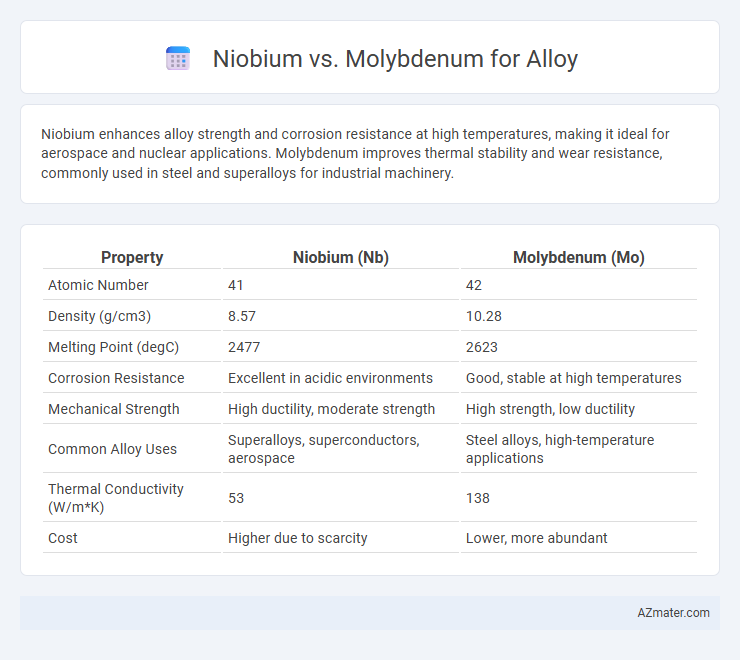Niobium enhances alloy strength and corrosion resistance at high temperatures, making it ideal for aerospace and nuclear applications. Molybdenum improves thermal stability and wear resistance, commonly used in steel and superalloys for industrial machinery.
Table of Comparison
| Property | Niobium (Nb) | Molybdenum (Mo) |
|---|---|---|
| Atomic Number | 41 | 42 |
| Density (g/cm3) | 8.57 | 10.28 |
| Melting Point (degC) | 2477 | 2623 |
| Corrosion Resistance | Excellent in acidic environments | Good, stable at high temperatures |
| Mechanical Strength | High ductility, moderate strength | High strength, low ductility |
| Common Alloy Uses | Superalloys, superconductors, aerospace | Steel alloys, high-temperature applications |
| Thermal Conductivity (W/m*K) | 53 | 138 |
| Cost | Higher due to scarcity | Lower, more abundant |
Introduction to Niobium and Molybdenum in Alloy Production
Niobium and molybdenum are critical elements in alloy production, valued for their ability to enhance strength, corrosion resistance, and high-temperature stability. Niobium is predominantly used in steel alloys to improve toughness and weldability, especially in aerospace and automotive applications. Molybdenum, with exceptional high-temperature strength and resistance to wear, plays a vital role in stainless steels and superalloys used in power plants and chemical processing industries.
Chemical and Physical Properties Comparison
Niobium exhibits a melting point of 2477degC and has excellent corrosion resistance, making it ideal for high-strength, lightweight alloys in aerospace and superalloy applications. Molybdenum, with a higher melting point of 2623degC, displays superior thermal conductivity and hardness, contributing to increased strength and wear resistance in high-temperature environments. Both elements enhance alloy performance by stabilizing microstructures, but niobium improves ductility and weldability while molybdenum significantly boosts strength and thermal stability.
Alloying Effects: Strength and Hardness Differences
Niobium significantly enhances alloy strength by forming fine, stable carbides that improve grain refinement and resistance to creep at high temperatures. Molybdenum contributes to increased hardness and corrosion resistance through solid-solution strengthening and carbide precipitation, especially in stainless steels and high-speed tool alloys. The choice between niobium and molybdenum depends on the required balance of toughness, wear resistance, and thermal stability in the alloy's final application.
Corrosion and Oxidation Resistance
Niobium alloys exhibit superior corrosion resistance in acidic and oxidizing environments due to the formation of a stable, protective oxide layer, making them ideal for chemical processing applications. Molybdenum enhances oxidation resistance at high temperatures by forming a dense molybdenum oxide scale, but its corrosion resistance in highly acidic conditions is generally lower than niobium. The choice between niobium and molybdenum in alloys depends on the specific corrosion environment, with niobium favored for aggressive acidic media and molybdenum preferred for high-temperature oxidation resistance.
Melting Points and Thermal Stability
Niobium exhibits a melting point of 2,468degC, significantly higher than molybdenum's melting point of 2,623degC, indicating superior thermal stability in high-temperature alloy applications. Its excellent resistance to oxidation and creep at elevated temperatures makes niobium alloys suitable for aerospace and nuclear industries. Molybdenum, while also thermally stable, offers enhanced hardness and corrosion resistance, preferred in environments requiring durability under thermal stress.
Industrial Applications: Niobium vs Molybdenum
Niobium significantly enhances the strength and corrosion resistance of steel alloys, making it ideal for automotive, aerospace, and pipeline applications where durability is critical. Molybdenum excels in high-temperature environments due to its superior thermal stability and ability to resist creep, making it essential in power plants, chemical processing, and furnace components. Both elements optimize alloy performance, but niobium is favored for structural reinforcement while molybdenum is preferred for thermal and chemical resilience.
Cost-Effectiveness and Market Availability
Niobium offers superior cost-effectiveness in alloy production due to its lower raw material costs and ability to enhance strength at smaller concentrations compared to molybdenum. Molybdenum, while providing excellent high-temperature and corrosion resistance, tends to be more expensive with less abundant market availability, impacting supply stability. The niobium market benefits from steady supply chains primarily sourced from Brazil and Canada, making it a preferred choice for economically scaling alloy manufacturing.
Ease of Fabrication and Processing
Niobium alloys offer superior ease of fabrication due to their excellent ductility and lower melting point compared to molybdenum, allowing for more efficient forming and welding processes. Molybdenum's higher melting point and brittleness present challenges in machining and require specialized equipment to maintain dimensional stability during processing. Niobium's favorable oxidation resistance at moderate temperatures further reduces the complexity of protective atmospheres needed during alloy fabrication.
Environmental and Sustainability Considerations
Niobium enhances steel alloys by improving strength and corrosion resistance, allowing for lighter and more fuel-efficient vehicles, which reduces carbon emissions during usage. Molybdenum also increases alloy durability but often requires higher energy inputs in extraction and processing, leading to greater environmental impacts. The recycling rates of niobium are higher compared to molybdenum, supporting more sustainable alloy production practices.
Choosing the Right Metal: Niobium or Molybdenum for Your Alloy
Niobium offers superior corrosion resistance and excellent ductility, making it ideal for aerospace and nuclear alloys where durability and strength are critical. Molybdenum excels in high-temperature stability and hardness, frequently used in stainless steel and superalloys for enhanced wear resistance. Selecting between niobium and molybdenum depends on specific application requirements, including operating temperature, mechanical properties, and environmental exposure.

Infographic: Niobium vs Molybdenum for Alloy
 azmater.com
azmater.com